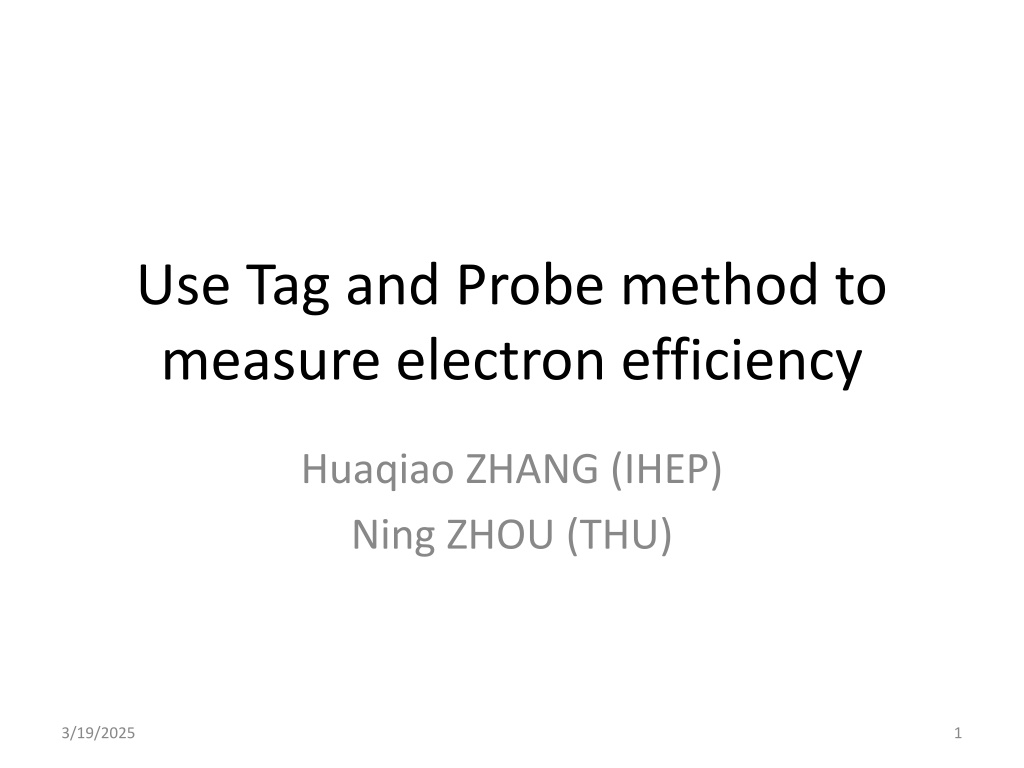
Efficient Electron Measurement Using Tag and Probe Method
Learn about the Tag and Probe method for measuring electron efficiency in particle physics, where one electron leg is tagged and the other is probed to calculate efficiency. Explore the selection process, efficiency calculation, contamination considerations, and detector coordinates in the ATLAS/CMS system.
Download Presentation

Please find below an Image/Link to download the presentation.
The content on the website is provided AS IS for your information and personal use only. It may not be sold, licensed, or shared on other websites without obtaining consent from the author. If you encounter any issues during the download, it is possible that the publisher has removed the file from their server.
You are allowed to download the files provided on this website for personal or commercial use, subject to the condition that they are used lawfully. All files are the property of their respective owners.
The content on the website is provided AS IS for your information and personal use only. It may not be sold, licensed, or shared on other websites without obtaining consent from the author.
E N D
Presentation Transcript
Use Tag and Probe method to measure electron efficiency Huaqiao ZHANG (IHEP) Ning ZHOU (THU) 3/19/2025 1
The question in particle physics Total Selected electron efficiency Describe the probability that a electron is detected by the detector Used to predict total electrons based on observed electrons Cross-section = N_selected/(efficiency*Luminosity) Defined as detected electrons over total electrons electron passes ID over all electrons before any ID Very straight forward for simulation, how for data Data is a mixture of everything: your selected electrons may contain fakes; difficult to know the total electrons => how do you know if it is an electron before you do any identification? Solution: Tag and Probe method 3/19/2025 2
What is tag and probe method Use well-known resonances that decays to pair of electrons, called it has 2 legs Usually Z, J/psi, or Y etc Select one well reconstructed electron leg We call it Tag The other leg without any selection We call it Probe, it is an electron since Z/jpsi decay to a pair of electron Use Probe samples as the total electrons Calculate efficiency by apply electron ID on probes 3/19/2025 3
How to perform Tag and Probe (1) How to select tag and probe unbiasly: You have 2 legs, at lease one have to pass your selection to be sure this event will be selected Loop over all legs vs assign Tag randomly: Efficiency calculation Leg 1 Leg 2 comments pass pass selected pass fail selected fail pass selected fail fail Not selected 3/19/2025 4
How to perform Tag and Probe (2) How to select get passed and failed events: You always have contaminations Fit tag+passed and tag+failed events separately Model with signal(BW + gauss) + backgrounds(pol/exp) 3/19/2025 5
ATLAS/CMS detector coordinates(1) (0,0,0): the geometry center of the detector X,Y plate is vertical to beam line X direction: pointing to LHC ring center Y direction: pointing upwards to the sky Right handed coordinate give Z direction along beam line 3/19/2025 6
ATLAS/CMS detector coordinates(2) Cylindrical-coordinate system Theta: polar angle from beam axis Eta(pseudorapidity): -ln[tan (theat/2)] Phi: azimuthal angle 3/19/2025 7
How to show the efficiency (1) Electron ID Efficiency usually depending on Pt, eta, phi (eta structure created by Prof. ZHOU) Bining with Pt/eta/phi, and do efficiency estimation at each bin independently 2 questions Why use eta(not theta) at LHC? Lorentz Invariant with boosts along Z/beam direction How to binning with eta? Depending on the detector design 3/19/2025 8
How to show the efficiency (2) examples 2D efficiency 1D efficiency 3/19/2025 9
How to show the efficiency (3) The uncertainties Statistical uncertainty Systematics uncertainty (not consider in this tutorial) Explain how you calculate the uncertainty and Why https://root.cern.ch/doc/master/classTEfficiency.html Example trigger efficiency of a CMS analysis 3/19/2025 10
Want to play with real data? Open data protocol for everyone analysis LHC data http://opendata.cern.ch Particular CMS data could do Tag and Probe studies (very big data files) http://opendata.cern.ch/record/202 A simplified data Z->ee analysis example Data: http://opendata.cern.ch/record/231 instructions: http://opendata.cern.ch/record/234 3/19/2025 11
Thanks 3/19/2025 12
